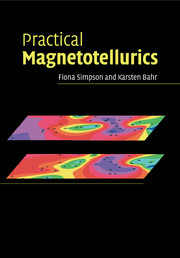Book contents
- Frontmatter
- Contents
- Preface
- Symbols
- 1 Introduction
- 2 Basic theoretical concepts
- 3 Planning a field campaign
- 4 From time series to transfer functions: data processing
- 5 Dimensionality and distortion
- 6 Numerical forward modelling
- 7 Inversion of MT data
- 8 The general link to other geosciences: conduction mechanisms
- 9 The special link to other geosciences
- 10 Other EM induction techniques
- Appendix 1 Theorems from vector calculus
- Appendix 2 The transfer function in the wavenumber-frequency domain and equivalence transfer functions
- Appendix 3 Probability distributions
- Appendix 4 Linear regression
- Appendix 5 Fourier analysis
- Appendix 6 Power and cross spectra
- Glossary
- References
- Index
5 - Dimensionality and distortion
Published online by Cambridge University Press: 03 December 2009
- Frontmatter
- Contents
- Preface
- Symbols
- 1 Introduction
- 2 Basic theoretical concepts
- 3 Planning a field campaign
- 4 From time series to transfer functions: data processing
- 5 Dimensionality and distortion
- 6 Numerical forward modelling
- 7 Inversion of MT data
- 8 The general link to other geosciences: conduction mechanisms
- 9 The special link to other geosciences
- 10 Other EM induction techniques
- Appendix 1 Theorems from vector calculus
- Appendix 2 The transfer function in the wavenumber-frequency domain and equivalence transfer functions
- Appendix 3 Probability distributions
- Appendix 4 Linear regression
- Appendix 5 Fourier analysis
- Appendix 6 Power and cross spectra
- Glossary
- References
- Index
Summary
So you managed to estimate some transfer functions for your first site, and the penetration depth for the period one hour is 3500 km! This is in the outer core of the Earth, and although we learned in Chapter 2 that the penetration depth depends on both period and conductivity, 3500 km is certainly deeper than we should expect to probe in any tectonic environment. What is going on? The transfer functions are affected by ‘static shift’, caused by small-scale conductivity contrasts. The ‘shift’ refers to the apparent resistivity curve, which is in fact shifted (in your case: towards a larger apparent resistivity, but a shift in the opposite direction can also occur). The shift is called ‘static’, because the underlying physical principle, the conservation of current at conductivity discontinuities, is not a time-dependent process like, for example, induction. Therefore, the phenomenon of static shift does not affect the phase of the transfer function. However, in complex conductivity distributions, frequency-independent distortion effects, commonly referred to as ‘galvanic effects’, can result in mixing of the phases belonging to transfer functions describing two horizontal directions (e.g., parallel and perpendicular to a vertical boundary). Sophisticated techniques for recovering the undistorted transfer functions have been developed. Three mistakes frequently occur: not using any of these techniques where they are necessary, over-using them in simple cases, and ignoring indications that the assumptions underlying these techniques have broken down (due, for example, to poor data quality, or three-dimensional (3-D) induction).
Information
- Type
- Chapter
- Information
- Practical Magnetotellurics , pp. 79 - 116Publisher: Cambridge University PressPrint publication year: 2005
